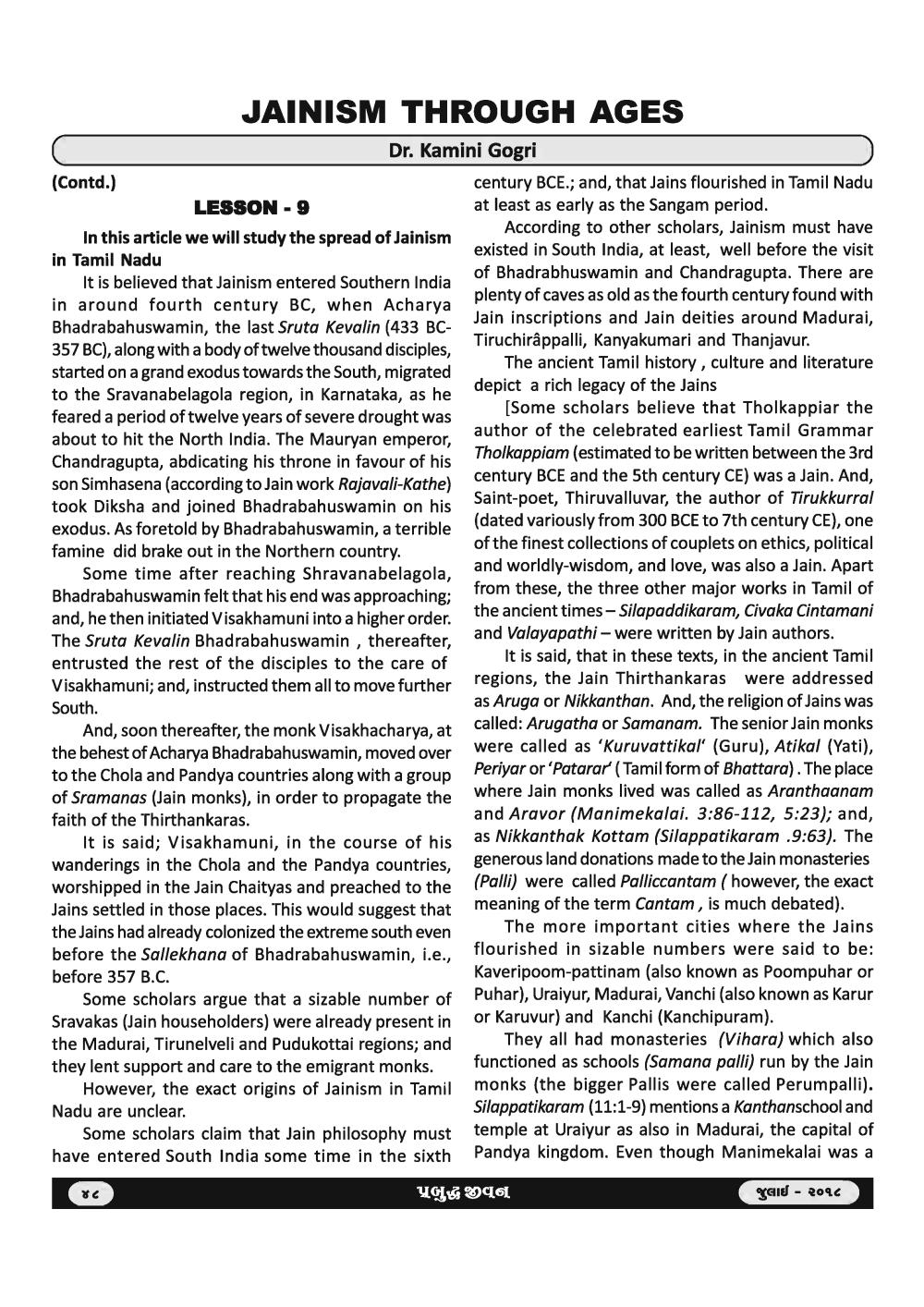________________
(Contd.)
JAINISM THROUGH AGES
Dr. Kamini Gogri
LESSON - 9
In this article we will study the spread of Jainism in Tamil Nadu
It is believed that Jainism entered Southern India in around fourth century BC, when Acharya Bhadrabahuswamin, the last Sruta Kevalin (433 BC357 BC), along with a body of twelve thousand disciples, started on a grand exodus towards the South, migrated to the Sravanabelagola region, in Karnataka, as he feared a period of twelve years of severe drought was about to hit the North India. The Mauryan emperor, Chandragupta, abdicating his throne in favour of his son Simhasena (according to Jain work Rajavali-Kathe) took Diksha and joined Bhadrabahuswamin on his exodus. As foretold by Bhadrabahuswamin, a terrible famine did brake out in the Northern country.
Some time after reaching Shravanabelagola, Bhadrabahuswamin felt that his end was approaching; and, he then initiated Visakhamuni into a higher order. The Sruta Kevalin Bhadrabahuswamin, thereafter, entrusted the rest of the disciples to the care of Visakhamuni; and, instructed them all to move further South.
And, soon thereafter, the monk Visakhacharya, at the behest of Acharya Bhadrabahuswamin, moved over to the Chola and Pandya countries along with a group of Sramanas (Jain monks), in order to propagate the faith of the Thirthankaras.
It is said; Visakhamuni, in the course of his wanderings in the Chola and the Pandya countries, worshipped in the Jain Chaityas and preached to the Jains settled in those places. This would suggest that the Jains had already colonized the extreme south even before the Sallekhana of Bhadrabahuswamin, i.e.,
before 357 B.C.
Some scholars argue that a sizable number of Sravakas (Jain householders) were already present in the Madurai, Tirunelveli and Pudukottai regions; and they lent support and care to the emigrant monks.
However, the exact origins of Jainism in Tamil Nadu are unclear.
Some scholars claim that Jain philosophy must have entered South India some time in the sixth
૪૮
century BCE.; and, that Jains flourished in Tamil Nadu at least as early as the Sangam period.
According to other scholars, Jainism must have existed in South India, at least, well before the visit
of Bhadrabhuswamin and Chandragupta. There are plenty of caves as old as the fourth century found with Jain inscriptions and Jain deities around Madurai, Tiruchirappalli, Kanyakumari and Thanjavur.
The ancient Tamil history, culture and literature
depict a rich legacy of the Jains
[Some scholars believe that Tholkappiar the author of the celebrated earliest Tamil Grammar Tholkappiam (estimated to be written between the 3rd century BCE and the 5th century CE) was a Jain. And, Saint-poet, Thiruvalluvar, the author of Tirukkurral (dated variously from 300 BCE to 7th century CE), one of the finest collections of couplets on ethics, political
and worldly-wisdom, and love, was also a Jain. Apart from these, the three other major works in Tamil of the ancient times-Silapaddikaram, Civaka Cintamani and Valayapathi - were written by Jain authors.
It is said, that in these texts, in the ancient Tamil regions, the Jain Thirthankaras were addressed as Aruga or Nikkanthan. And, the religion of Jains was called: Arugatha or Samanam. The senior Jain monks were called as 'Kuruvattikal' (Guru), Atikal (Yati), Periyar or 'Patarar' (Tamil form of Bhattara). The place where Jain monks lived was called as Aranthaanam and Aravor (Manimekalai. 3:86-112, 5:23); and, as Nikkanthak Kottam (Silappatikaram .9:63). The generous land donations made to the Jain monasteries (Palli) were called Palliccantam (however, the exact meaning of the term Cantam, is much debated).
The more important cities where the Jains flourished in sizable numbers were said to be: Kaveripoom-pattinam (also known as Poompuhar or Puhar), Uraiyur, Madurai, Vanchi (also known as Karur or Karuvur) and Kanchi (Kanchipuram).
They all had monasteries (Vihara) which also functioned as schools (Samana palli) run by the Jain monks (the bigger Pallis were called Perumpalli). Silappatikaram (11:1-9) mentions a Kanthanschool and temple at Uraiyur as also in Madurai, the capital of Pandya kingdom. Even though Manimekalai was a
જુલાઈ - ૨૦૧૮
પ્રબુદ્ધજીવન




